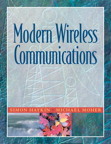An Engineering Approach to Computer Networking
暫譯: 計算機網絡的工程方法
Srinivasan Keshav
- 出版商: Addison Wesley
- 出版日期: 1997-05-15
- 售價: $980
- 貴賓價: 9.8 折 $960
- 語言: 英文
- 頁數: 688
- 裝訂: Paperback
- ISBN: 0201634422
- ISBN-13: 9780201634426
-
相關分類:
Computer-networks
下單後立即進貨 (約5~7天)
買這商品的人也買了...
-
 Expert C Programming: Deep C Secrets (Paperback)
Expert C Programming: Deep C Secrets (Paperback)$1,700$1,615 -
 Practical C Programming, 3/e (Paperback)
Practical C Programming, 3/e (Paperback)$1,414$1,339 -
 Wireless Personal Communications Systems (Hardcover)
Wireless Personal Communications Systems (Hardcover)$1,040$1,019 -
 Discrete-Time Signal Processing, 2/e (修訂版)
Discrete-Time Signal Processing, 2/e (修訂版)$1,060$1,039 -
 Data Mining: Concepts and Techniques
Data Mining: Concepts and Techniques$2,510$2,385 -
 $825The Java Tutorial: A Short Course on the Basics, 3/e (Paperback)
$825The Java Tutorial: A Short Course on the Basics, 3/e (Paperback) -
 Introduction to Algorithms, 2/e (Hardcover)
Introduction to Algorithms, 2/e (Hardcover)$990$970 -
 Beginning Perl for Bioinformatics (Paperback)
Beginning Perl for Bioinformatics (Paperback)$1,330$1,260 -
 MOUS 主題式 Word 2000 Core 標準級指定精選教材
MOUS 主題式 Word 2000 Core 標準級指定精選教材$380$300 -
 Wireless Communications: Principles and Practice, 2/e
Wireless Communications: Principles and Practice, 2/e$1,100$1,078 -
 MOUS 主題式 Word 2000 Expert 專業級指定精選教材
MOUS 主題式 Word 2000 Expert 專業級指定精選教材$350$277 -
 Computer Networks, 4/e
Computer Networks, 4/e$1,150$1,127 -
 Windows Server 2003 網路與 IIS 架站指南
Windows Server 2003 網路與 IIS 架站指南$680$537 -
 重構─改善既有程式的設計
重構─改善既有程式的設計$720$569 -
 電腦網路 (Computer Networks, 4/e)
電腦網路 (Computer Networks, 4/e)$800$760 -
 Fundamentals of Database Systems, 4/e (IE)
Fundamentals of Database Systems, 4/e (IE)$1,090$1,068 -
 Modern Wireless Communications (美國版 0130224723)
Modern Wireless Communications (美國版 0130224723)$1,000$980 -
 Visual Basic 6 初學指引
Visual Basic 6 初學指引$480$408 -
 計算機概論:探索未來
計算機概論:探索未來$650$553 -
 Java How to Program, 6/e (IE)(美國版ISBN:0131483986)
Java How to Program, 6/e (IE)(美國版ISBN:0131483986)$1,140$1,117 -
 資料庫系統原理 (Fundamentals of Database Systems, 4/e)
資料庫系統原理 (Fundamentals of Database Systems, 4/e)$860$679 -
 ASP.NET 2.0 深度剖析範例集
ASP.NET 2.0 深度剖析範例集$650$507 -
 Linux 驅動程式, 3/e (Linux Device Drivers, 3/e)
Linux 驅動程式, 3/e (Linux Device Drivers, 3/e)$980$774 -
 Visual Basic 2005 完全探索
Visual Basic 2005 完全探索$550$468 -
 Visual Basic 6 初學指引(修訂版)
Visual Basic 6 初學指引(修訂版)$480$408
相關主題
商品描述
Description
This practical introduction to computer networking takes a highly effective "engineering" approach that not only describes how networks operate but also offers insight into the principles of network design. An Engineering Approach to Computer Networking simultaneously studies all three major network technologies-Asynchronous Transfer Mode (ATM), the Internet, and telephony. You will find clear overviews of these technologies and extensive up-to-date coverage of all essential networking topics: protocol layering; multiple access; switching; scheduling; naming, addressing, and routing; error and flow control; and traffic management. For each topic, the book identifies fundamental constraints and analyzes the pros and cons of several alternative solutions. It shows you how these concepts are put to use in real networks with detailed descriptions of common protocols used in the telephone, Internet, and ATM networks, and a tour of system design and protocol implementation techniques. ![]()
Table Of Contents
(Most chapters contain a Summary.)
Preface xiii.
SECTION II. INTRODUCTION.
1. Atoms, Bits, and Networks.Common Network Technologies.
Networking Concepts and Techniques.
Engineering Computer Networks.
In Closing.
2. The Telephone Network: Concepts, History, and Challenges.
End-Systems.
Transmission.
Switching.
Signaling.
Cellular Communications.
Historical Sketch.
Challenges.
Summary.
3. The Internet: Concepts, History, and Challenges.
Basic Internet Technology.
Addressing.
Routing.
Endpoint Control.
History.
Challenges.
Summary.
4. Atm Networks: Concepts, History, and Challenges.
Fixed-Size Packets.
Small Packet Size.
Statistical Multiplexing.
Integrated Service.
History.
Challenges.
Summary.
SECTION II. TOOLS AND TECHNIQUES.
5. Protocol Layering.
Importance of Layering.
Problems With Layering.
Iso-Osi Reference Model.
The Seven Layers.
Summary.
6. System Design.
Resource Constraints and Their Metrics.
Common Design Techniques.
Performance Analysis and Tuning.
Summary.
7. Multiple Access.
Choices and Constraints.
Base Technologies.
Centralized Access Schemes.
Distributed Schemes.
Summary.
8. Switching.
Circuit Switching.
Packet Switching.
Switch Fabrics.
Buffering.
Multicasting.
Summary.
9. Scheduling.
Requirements.
Fundamental Choices.
Scheduling Best-Effort Connections.
Scheduling Guaranteed-Service Connections.
Comparison.
Packet Dropping.
Summary.
10. Naming and Addressing.
Naming and Addressing.
Hierarchical Naming.
Addressing.
Addressing in the Telephone Network.
Addressing in the Internet.
Nsaps: Addressing in ATM Networks.
Name Resolution.
Datalink Layer Addressing.
Finding Datalink Layer Addresses.
Summary.
11. Routing.
Routing Protocol Requirements.
Choices.
Routing in the Telephone Network.
Distance-Vector Routing.
Link-State Routing.
Choosing Link Costs.
Hierarchical Routing.
Internet Routing Protocols.
Routing Within a Broadcast Lan.
Multicast Routing.
Routing With Policy Constraints.
Routing for Mobile Hosts.
Summary.
12. Error Control.
Bit-Error Detection and Correction.
Causes of Packet Errors.
Packet-Error Detection and Correction.
Summary.
13. Flow Control.
Classification.
Open-Loop Flow Control.
Closed-Loop Flow Control.
Hybrid Flow Control.
Summary.
14. Traffic Management.
An Economic Framework for Traffic Management.
Traffic Models.
Traffic Classes.
Time Scales of Traffic Management.
Scheduling.
Renegotiation.
Signaling.
Admission Control.
Peak-Load Pricing.
Capacity Planning.
Summary.
SECTION III. PRACTICE.
15. Common Protocols.
Telephone Network Protocols.
Internet Protocols.
Atm Network Protocols.
Ip Over Atm.
Summary.
16. Protocol Implementation.
Factors Affecting Protocol Stack Performance.
Common Protocol Stack Procedures.
Partitioning Strategies.
Interface Among Protocol Layers.
Protocol Implementation.
Some Rules of Thumb.
Summary.
References.
Glossary.
Answers to Review Questions and Selected Exercises.
Index. 0201634422T04062001
商品描述(中文翻譯)
描述
這本實用的計算機網絡入門書採取了一種非常有效的「工程」方法,不僅描述了網絡的運作方式,還提供了網絡設計原則的深入見解。《計算機網絡的工程方法》同時研究了三種主要的網絡技術——非同步傳輸模式 (ATM)、互聯網和電話通信。您將找到這些技術的清晰概述,以及所有基本網絡主題的廣泛最新覆蓋:協議分層;多重存取;交換;排程;命名、尋址和路由;錯誤和流量控制;以及流量管理。對於每個主題,本書識別了基本約束並分析了幾種替代解決方案的優缺點。它展示了這些概念如何在實際網絡中應用,詳細描述了在電話、互聯網和ATM網絡中使用的常見協議,以及系統設計和協議實現技術的概覽。
目錄
(大多數章節包含摘要。)
前言 xiii。
第二部分:介紹。
1. 原子、位元和網絡。
介紹。
常見網絡技術。
網絡概念和技術。
工程計算機網絡。
結語。
2. 電話網絡:概念、歷史和挑戰。
概念。
終端系統。
傳輸。
交換。
信號傳送。
行動通信。
歷史簡介。
挑戰。
摘要。
3. 互聯網:概念、歷史和挑戰。
概念。
基本互聯網技術。
尋址。
路由。
端點控制。
歷史。
挑戰。
摘要。
4. ATM網絡:概念、歷史和挑戰。
虛擬電路。
固定大小的封包。
小封包大小。
統計多工。
綜合服務。
歷史。
挑戰。
摘要。
第二部分:工具和技術。
5. 協議分層。
協議和協議分層。
分層的重要性。
分層的問題。
ISO-OSI參考模型。
七層模型。
摘要。
6. 系統設計。
介紹。
資源約束及其度量。
常見設計技術。
性能分析和調整。
摘要。
7. 多重存取。
介紹。
選擇和約束。
基本技術。
集中式存取方案。
分散式方案。
摘要。
8. 交換。
介紹。
電路交換。
封包交換。
交換結構。
緩衝。
多播。
摘要。
9. 排程。
介紹。
需求。
基本選擇。
排程最佳努力連接。
排程保證服務連接。
比較。
封包丟棄。
摘要。
10. 命名和尋址。
介紹。
命名和尋址。
分層命名。
尋址。
電話網絡中的尋址。
互聯網中的尋址。
ATM網絡中的尋址。
名稱解析。
數據鏈路層尋址。
尋找數據鏈路層地址。
摘要。
11. 路由。
介紹。
路由協議需求。
選擇。
電話網絡中的路由。
距離向量路由。
鏈路狀態路由。
選擇鏈路成本。
分層路由。
互聯網路由協議。
廣播局域網中的路由。
多播路由。
帶有政策約束的路由。
移動主機的路由。
摘要。
12. 錯誤控制。
位元錯誤的原因。
位元錯誤檢測和修正。
封包錯誤的原因。
封包錯誤檢測和修正。
摘要。
13. 流量控制。
模型。
分類。
開環流量控制。
閉環流量控制。
混合流量控制。
摘要。
14. 流量管理。
介紹。
流量管理的經濟框架。
流量模型。
流量類別。
流量管理的時間尺度。
排程。
重新協商。
信號傳送。
接納控制。
高峰定價。
容量規劃。
摘要。
第三部分:實踐。
15. 常見協議。
介紹。
電話網絡協議。
互聯網協議。
ATM網絡協議。
IP over ATM。
摘要。
16. 協議實現。
介紹。
影響協議堆疊性能的因素。
常見的協議堆疊程序。
分區策略。
協議層之間的介面。
協議實現。
一些經驗法則。
摘要。
參考文獻。
詞彙表。
回顧問題和選定練習的答案。
索引。 0201634422T04062001












